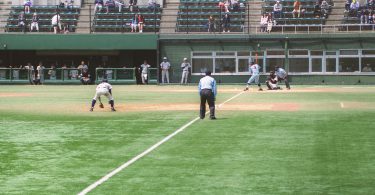The Situation:
It’s a 2-0 game in favor of the home team in the bottom of the 4th inning. The right-handed pitcher has been cruising as he toes the rubber to start the inning against the 3-hole hitter.
The Play:
The first pitch of the inning is a curveball that loops in over the plate for a called strike. The second pitch is a fastball that sizzles in on the inner third of the plate. The batter takes a hack, but is late. Drawing his hands in at the last second, he is able to foul it off with a late, ugly swing. Down 0-2, the pitcher has him right where he wants. He can elevate the fastball and blow him away, he can have him chase a breaking ball down and out of the zone that tunnels well with the last pitch, or any other pitch. The hitter is vulnerable and defensive. It’s the perfect situation. But the pitcher, not wanting to make a mistake and give up a hit on 0-2 decides he will waste a pitch. He rears back and fires a fastball that’s a ball out of the hand and the batter takes without hesitation as the ball comes in helmet high.
The Outcome:
The count is 1-2, and the hitter has gained a little more confidence. The next pitch, the pitcher tries to go back to the breaking ball, but the hitter spits on it in the dirt. His confidence grows. Now at 2-2, he is working his way back in the count and expects a fastball. The pitcher, not wanting to go 0-2 to 3-2 gives the hitter what he’s expecting and throws a fastball for a strike. The hitter, on time and ready to do damage, crushes it into the right centerfield gap for a stand-up double.
What Went Wrong:
There are a few things that went wrong, starting with the pitchers mentality. He got to 0-2 by being aggressive and executing pitches. The batter was reeling and in the most vulnerable count there is. Instead of attacking with another competitive pitchers’ pitch, he pitches not to make a mistake. A “waste pitch” is an old school term that was meant to remind a pitcher to be careful not to make a mistake over the plate when way ahead in the count. A waste pitch mentality is uncompetitive and the term is outdated.
When the hitter is at his most vulnerable, why would you want to give him an easy take or let off the gas? Pitching scared or without conviction that you can execute the pitch is no way to pitch. In this case, the pitcher needs to focus on executing a competitive chase pitch. Giving up 0-2 hits is something that is easy to track, so if a pitcher is giving up too many, he can change his pitch selection to a safer pitch, but by “wasting a pitch”, the pitcher is letting the batter back into the count, growing his confidence, and literally wasting a pitch on his pitch-count.
Pitch selection is an important part of pitching, and being able to read swings and sequence multiple pitches so they are most effective is what learning to be a great pitcher is all about. Learn from this pitcher’s mistakes and always throw with conviction. Try to keep every pitch you throw competitive. That doesn’t mean that every pitch you throw needs to be in the strike zone, but every pitch thrown should pressure the hitter to make a swing/no swing decision and have an intended competitive purpose (like setting up the next pitch). This scenario is a good lesson to always compete with confidence on the mound and always think the game!
For more information on pitch sequencing, check out this informative article by the guys at Driveline Baseball on data-driven pitch sequencing.







